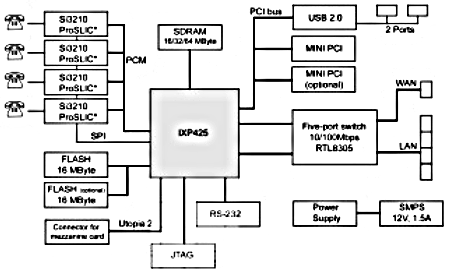Ref design for network devices includes hardware, uClinux
Jun 30, 2004 — by LinuxDevices Staff — from the LinuxDevices Archive — 4 views CyberGuard and Intel have teamed up on a hardware/software reference design for network devices based on uClinux. The design includes a SnapGear Linux (uClinux) development kit from Cyberguard, and an XScale based reference board from Intel. It targets OEMs developing edge networking and residential gateway equipment.
CyberGuard and Intel have teamed up on a hardware/software reference design for network devices based on uClinux. The design includes a SnapGear Linux (uClinux) development kit from Cyberguard, and an XScale based reference board from Intel. It targets OEMs developing edge networking and residential gateway equipment.
(Click for slightly larger view of Intel reference board)
The reference design includes Intel's IXDPG425 Network Gateway Development Platform, along with CyberGuard's SE4500 “secure edge” uClinux OS and development tools.
The board
The IXDPG425 board is based on an Intel XScale IXP425 “network processor” system-on-chip (SoC). CyberGuard acquisition SnapGear first marketed a development kit for the IXP4xx last August.
The IXP425 SoC is based on an ARM RISC core which clocks up to 533MHz has has 64k of cache. It integrates an SDRAM controller, two high-speed serial ports, two 10/100Mbit Ethernet ports, a UTOPIA interface for ATM / xDSL, a PCI bus, host USB, and an encryption accelerator. The board makes ample use of the SoC's peripherals, offering a host of ports and features.

Diagram of SE4500 architecture
CyberGuard lists the following features for the Intel reference board:
- Intel XScale. RISC core up to 533 MHz (266, 400, 533MHz)
- Three network processor engines
- Two high-speed serial ports
- Two 10/100 Base-T Ethernet MACs with MII/RMII interface
- UTOPIA 2 interface, multiple ADSL/G.SHDSL or VDSL support
- PCI version 2.2 Host and Option interface
- Hardware Security Accelerator (IPsec: DES, 3DES, SHA-1, MD5)
- USB version 1.1 device controller
- Two UARTS capable of supporting 921 Kbps
- 32-bit wide SDRAM controller
- Sixteen GPIO pins
- 16-bit configurable expansion bus
- ATM, TDM, Ethernet MAC filtering, and HDLC support
- Both Commercial (0° to 70° C) and Extended (-40° to +85° C) temperature options
- Support by integrated Linux development tool chain
CyberGuard's “SE4500” development kit
CyberGuard lists the following features and capabilities for its uClinux-based SE4500 software reference design and development kit, which it describes as “almost production ready:”
- Network Services
- PPPoE, xDSL, Cable
- Wi-Fi Client/AP 802.11b (now), 802.11g (GUI support under development)
- USB 1.1 Slave Device Capability
- ADSL Interface (GUI support under development)
- Bridging, GRE encapsulation, Fail over, DMZ, load balancing
- PPPoE, xDSL, Cable
- Firewall Services
- Stateful Packet Inspection (Netfilter/-IPtables)
- NAT, port forwarding, etc.
- Intrusion Detection Systems (Snort) - logging to external database
- VLAN segmentation (GUI support under development)
- Stateful Packet Inspection (Netfilter/-IPtables)
- VPN Services
- PPTP Client/Server and L2TP
- IPSec (DES, 3DES and AES with hardware encryption offload)
- IPSec IKE (FreeS/WAN)
- SSL termination (under development)
- PPTP Client/Server and L2TP
- Proxies
- Web Cache (Squid)
- URL filtering (Cerberian licence)
- Web Cache (Squid)
- Network Attached Storage
- IDE over USB 2.0 fixed disks with ext2 FS (GUI support under development)
- VoIP Services
- DSR Supported
- SIP Proxy (under development)
- SIP Stack for analog ports (TBD)
- DSR Supported
The development board is available immediately through Intel, and CyberGuard invites enquiries from interested OEMs. CyberGuard says it is currently working on a VoIP device implementation based on the reference design for a large telecommunications company. It previously used the design as the basis for secure remote mobile wireless units for a global e-commerce company, it says.
This article was originally published on LinuxDevices.com and has been donated to the open source community by QuinStreet Inc. Please visit LinuxToday.com for up-to-date news and articles about Linux and open source.